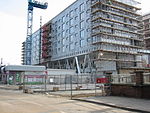Municipal Borough of Barking
Barking, LondonDistricts abolished by the London Government Act 1963Districts of England created by the Local Government Act 1894History of local government in London (1889–1965)History of the London Borough of Barking and Dagenham ... and 2 more
History of the London Borough of NewhamMunicipal boroughs of England

Barking was a local government district, and later civil parish and borough, in southwest Essex, England from 1882 to 1965. It was known as Barking Town from 1882 to 1931. The district included the town of Barking, eastern Beckton and the southwestern part of the Becontree estate. The district was within the Metropolitan Police District and experienced a steady increase in population during its existence. It now forms the western part of the London Borough of Barking and Dagenham and the eastern extremity of the London Borough of Newham in Greater London.
Excerpt from the Wikipedia article Municipal Borough of Barking (License: CC BY-SA 3.0, Authors, Images).Municipal Borough of Barking
Bobby Moore Way, London
Geographical coordinates (GPS) Address Nearby Places Show on map
Geographical coordinates (GPS)
| Latitude | Longitude |
|---|---|
| N 51.5358 ° | E 0.0785 ° |
Address
Bobby Moore Way
Bobby Moore Way
IG11 7LU London (London Borough of Barking and Dagenham)
England, United Kingdom
Open on Google Maps







